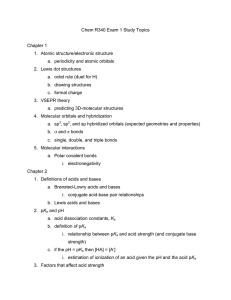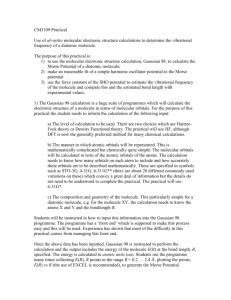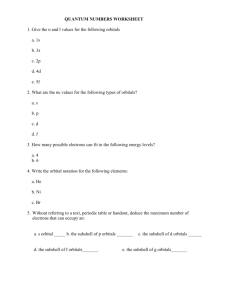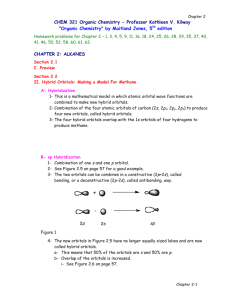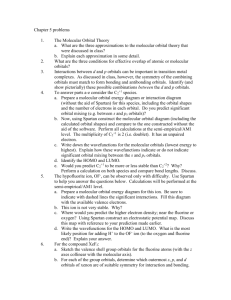(A) (B) - Anslyn
advertisement
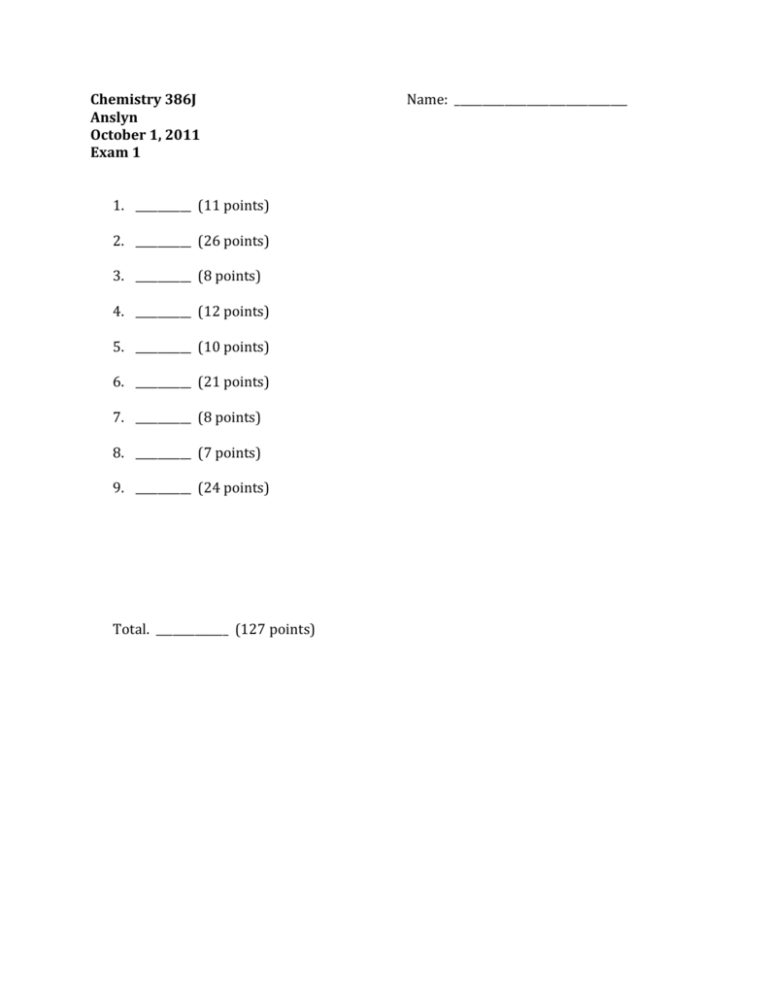
Chemistry 386J Anslyn October 1, 2011 Exam 1 1. __________ (11 points) 2. __________ (26 points) 3. __________ (8 points) 4. __________ (12 points) 5. __________ (10 points) 6. __________ (21 points) 7. __________ (8 points) 8. __________ (7 points) 9. __________ (24 points) Total. _____________ (127 points) Name: _______________________________ 1. This question refers to the two alkanes, labeled (A) and (B), shown below. a) Please provide the IUPAC name for each of these alkanes. Do not be concerned about R or S descriptors. (A): (B): b) Using Benson group increments provided on the previous page, calculate the ∆H°f values for these alkanes. c) The A-value for the methyl group is 1.74, and the value for a gauche interaction is 0.9 kcal/mol. Given these values, please correct the ∆H°f values that you calculated for the alkanes in part b) of this question. Make sure it is clear which new value of ∆H°f belongs to structure (A) and which belongs to structure (B). d) Now predict whether (A) or (B) will burn the hottest, giving the most exothermic ∆Hcomb value. How much of a difference in the heats of combustion will there be? 2. One of the main topics of chapter 1 was qualitative molecular orbital theory (QMOT). The following question pertains to this theory. a) Construct the Walsh diagram for a methyl group showing orbital energies for both planar and pyramidal forms (indicating which is which), as well as orbital phasing. b) Recall that the methyl group can have either a planar or pyramidal geometry depending on the number of electrons in the molecule. Referring to the Walsh diagram that you just drew, what would you expect the geometry of BH3 to be? Briefly explain your answer. c) Using an orbital mixing diagram, mix one of the π(CH3) group orbitals with a porbital in order to create a delocalized π-system of ethyl radical. Be sure to place the starting orbitals at the proper relative energy levels. Then make cartoon representations of what these new orbitals look like, and populate with electrons. d) Use the diagram that you just created to explain hyperconjugation. e) Using the two orbitals you created in the mixing diagram from part c), make the extended π-system of 2-butene consisting of four molecular orbitals. Then make cartoon representations of what these new orbitals look like. Fill in the molecular orbitals with the number of electrons you would expect for 2-butene. Finally, label the HOMO and the LUMO. f) We give below the π-molecular orbitals of 1,3-butadiene. Make a comparison between your answer to part e) and these orbitals. Explain how they are most similar, and how they are most different. 1,3-butadiene 3. Draw the mechanism for the following reaction, making sure to show all participating lone pairs, applicable formal charges, and required arrow pushing to indicate the flow of electrons. 4. The next question refers to the set of diols that are drawn below. Circle the diols that are chiral. Next, put a (*) near any structure that is meso. Then, state the relationship of the alcohol groups (homotopic, enantiotopic, diastereotopic) on the line below each diol. 5. Each of the molecules pictured is destabilized by at least one of the different types of strain discussed in class. In each molecule, indicate each type of strain that is present. Indicate where on the molecule that this strain occurs. a) b) c) d) e) 6. The following problem refers to the compound trans-1,2-dichlorocyclohexane. a) Make Newman projections for both of these conformations, looking down the bond that is indicated in the equilibrium. (A) (B) b) Identify strains that are associated with these conformations. List them with your drawing in part a). c) Using the Klyne-Prelog system, list under the heading in part a) the relationship between the chlorine atoms for each conformation. Do not be concerned with the + or – designation. d) Recall that a weaker bond has electrons in higher energy orbitals. Given that the BDE or a C-Cl bond is around 84 kcal/mol, and that a C-C bond is around 90 kcal/mol, which bond has electrons in the higher energy orbital? e) Structures (A) and (B) are redrawn below. In each drawing please point out the bonds that are anti-periplanar to the C-Cl bonds. If the C-Cl bonds are anti-periplanar to each other point that out also. f) In the gas phase, there is a slight preference for the diaxial compound (60:40). Given the knowledge you developed from parts d) and e), how can you rationalize this preference for the diaxial species? g) We again redraw structures (A) and (B) below. Please draw the bond dipoles and the resulting molecular dipoles for each conformation. If there is no molecular dipole, please state this. h) As mentioned in part f), the preference for (B) is noted in the gas phase. This is also true in non-polar solvents, but goes away as the polarity of the solvent is increased and (A) begins to dominate. Given that the higher polarity solvents will better solvate polar molecules, how can you account for the reverse in conformational preference? 7 . Cyclobutane cannot exist as a planar ring, since that would produce C-H and C-C bonds that were fully eclipsed. Thus, this molecule puckers to relieve some of this strain. A picture of puckered cyclobutane is shown below for your reference. Both possible conformations interconvert rapidly, with a barrier to rotation of 1.45 kcal/mol. a) Draw the possible conformations of puckered trans-1,3-dimethylcyclobutane (pictured to the right). b) Label the conformations you drew above, and denote which one (if any) would be the most stable. Briefly explain your designation. c) Draw the possible conformations of puckered cis-1,3-dimethylcyclobutane (pictured to the right). d) Label the conformations you drew above, and denote which one (if any) would be the most stable. Briefly explain your designation. e) Construct a potential energy diagram for the interconversion of the forms of the trans- isomer (represent this as a solid line), as well as the cis- isomer (represent this as a dashed line). Be sure to indicate the proper relative energies of the species. P.E. Torsion Angle 8. Thiourea, drawn below, has several different stretches in the IR spectrum. These absorption bands represent different degrees of freedom associated with this molecule. Three selected peaks can be found at at 2955, 1620, and 1378 cm.-1 N-H Stretch C=S Stretch C-N Stretch a) On the potential energy surface, draw the surface that represents these degrees of freedom. The exact curves are not important, but the relative shapes of the curve should be correct. b) Of your potential diagrams, which represents a motion with the most entropy? c) Of your potential diagrams, which motion has the largest force constant? 9. The following question refers to the two cyclohexane derivatives that are drawn below. a) Are these molecules chiral? b) Circle any stereocenters in both of these molecules. c) What stereochemical relationship does (A) have relative to (B)? d) If you were giving the IUPAC names, would you need to describe each stereocenter with an (R)- or an (S)- descriptor? Please briefly explain your answer. Sodium cyanide reacts with (A) and (B) in an SN2 fashion to give the products that are shown. e) Are these SN2 reactions stereoselective? Please explain your answer. f) Are these reactions stereospecific? Please explain your answer. Treatment of (A) and (B) with the base sodium ethoxide (NaOEt) leads to an elimination reaction, as shown below, giving new products (C) and (D). g) What is the stereochemical topicity relationship of the protons that are indicated on starting material (A)? h) Are (C) and (D) the same molecule? If no, what kind of isomers are they? i) Predict the ratio of the products (C) and (D) that are formed from the elimination of both (A) and (B). j) Are these reactions stereoselective? Please explain your answer. k) Are these reactions stereospecific? Please explain your answer. l) If the elimination reaction of (A) is carried out with a chiral base, as indicated below, do you expect the ratio of (C) to (D) to be 1:1 or something different? Explain your reasoning using your answer to part g).

